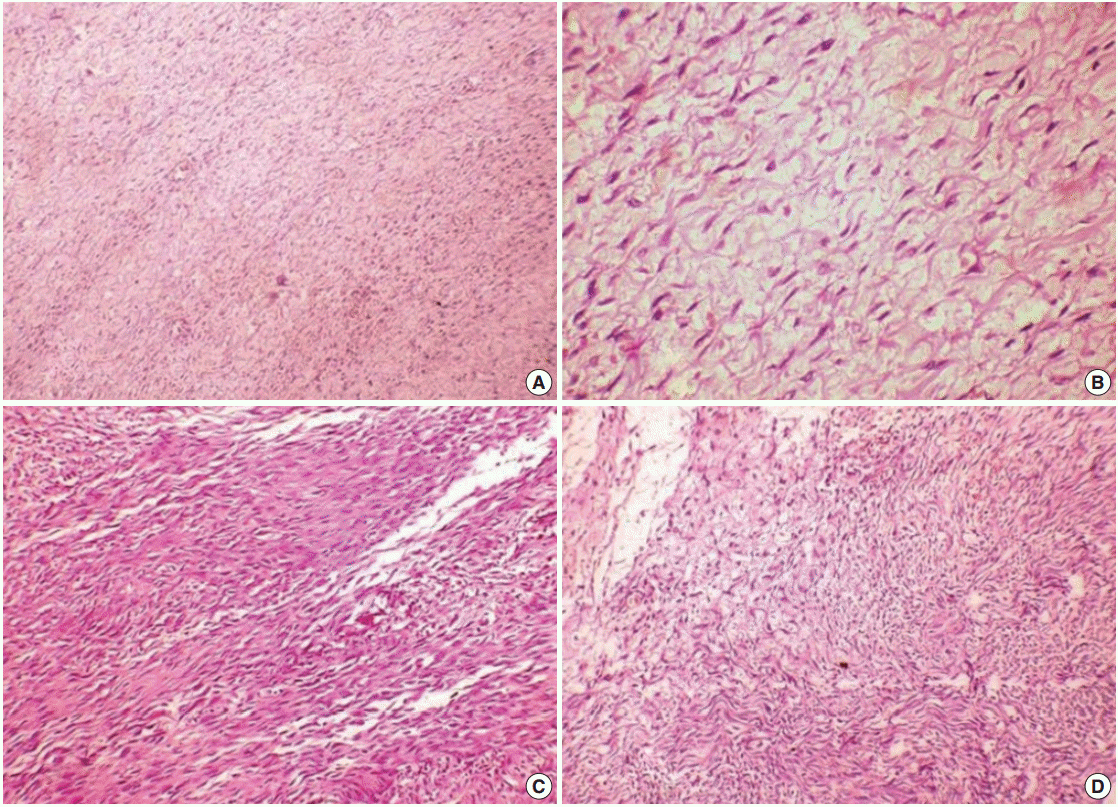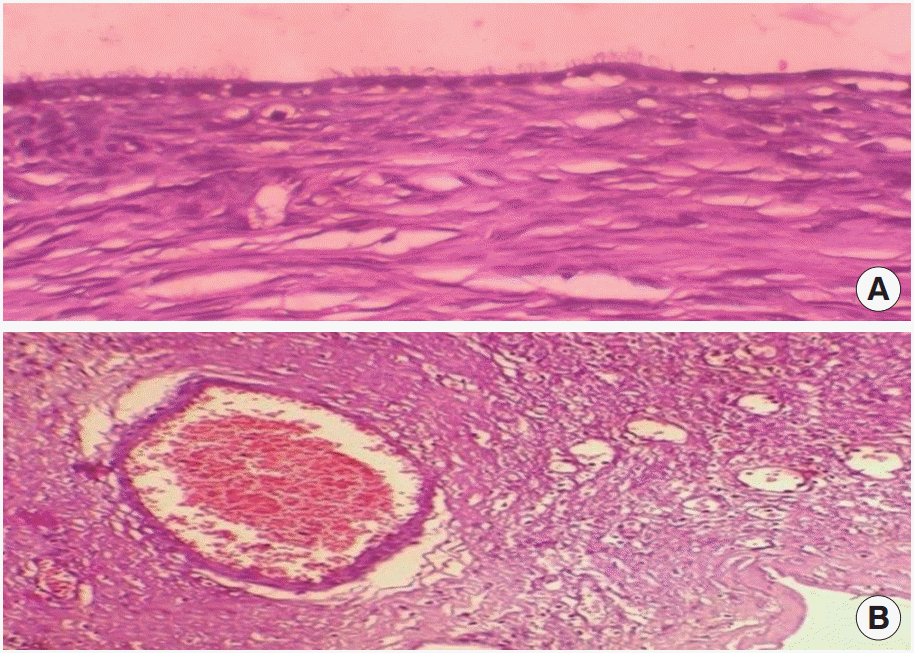Serous Cystadenoma and Fibrothecoma: A Rare Combination in Collision Tumor of Ovary with Pseudo-Meigs Syndrome
Article information
Collision tumors are best considered as separate primary neoplasms. These tumors have been reported in various organs, such as the esophagus, stomach, liver, thyroid gland, ovary, and lung, but they are extremely rare in the ovaries [1]. The majority of these tumors are a collision between carcinomas and sarcomas or lymphomas, and rarely between two types of carcinoma [2]. The most common histological combination of collision tumor in the ovary is the coexistence of teratoma with mucinous tumors (mucinous cystadenoma or carcinoma) [1]. Here we report a very unusual combination of fibrothecoma and serous cystadenoma in the left ovary of an elderly woman who presented with an abdominal lump and ascites.
CASE REPORT
A 63-year-old, parous, menopausal woman was admitted with complaints of abdominal distention for 3 months and difficulty in passing urine for 1 month. Physical examination revealed an abdominal lump and ultrasonography revealed a large cystic mass. A computed tomography (CT) scan revealed a large cystic lesion (22.7×15×20 cm) occupying the pelvis and abdomen, with a well delineated solid area (9×5 cm) within it. Minimal ascites were noted (Fig. 1A, B). No other significant findings, including pleural or pericardial effusion, were noted. Malignant neoplasm of the ovary was suspected.

(A, B) Computed tomography scan showing a large cystic lesion occupying the pelvis and abdomen (solid area), and minimal ascites. (C) Specimen of left ovarian cyst with well-demarcated solid yellow tumor mass (arrows).
Cytology of ascitic fluid showed a few reactive mesothelial cells. Malignant cells were not seen. Carcinoma antigen 125 (CA-125) levels were mildly elevated (0.42 IU/mL). A specimen from radical hysterectomy, including a left ovarian cystic mass, was received for histopathological examination.
On cutting, the left ovarian cyst leaked blood-tinged, serous fluid. The cut surface showed a large, uniloculated, thin walled cyst (20×18 cm) with a smooth surface and congested vessels. At one end of the cyst, we observed a well-demarcated, solid, homogeneous, yellow-white mass (8×6 cm) (Fig. 1C, arrows). A few areas of cystic changes were seen. Compressed ovarian tissue at the periphery and fallopian tube could be identified.
Histopathological examination of the solid area in the left ovarian mass showed a tumor composed of fascicles of loosely arranged spindle cells with variable cellularity and a variable amount of intervening collagen. The cells had oval to elongate nuclei with a moderate amount of pale to vacuolated cytoplasm (Fig. 2A, B). Nuclear atypia, mitotic activity, and edema were not seen in the tumor tissue. In places, closely packed spindle stromal cells were arranged in fascicles and a storiform pattern with hyaline collagen bands (Fig. 2C, D). No glandular structures were seen. A diagnosis of fibrothecoma was made.

Microscopy of solid tumor showing areas of thecoma (A, B), fibroma (C), and mixture of fibroma and thecoma (D).
Histopathological examination of the cyst showed a fibrocollagenous wall lined in places by cuboidal epithelium with cilia (Fig. 3A). Papillae were not seen. A diagnosis of serous cystadenoma was made. Sections from the junction of the two tumors showed normal ovarian stromal tissue with congested blood vessels (Fig. 3B). A final histological diagnosis of an ovarian collision tumor consisting of fibrothecoma and serous cystadenoma was made.
DISCUSSION
Collision tumors are defined as two adjacent but histologically distinct tumors, without admixture, in the same tissue or organ [1]. These tumors are rare clinical entities.
The majority of these tumors are a collision between carcinomas and sarcomas or lymphomas and have been reported in various organs. Collision tumors involving ovaries are extremely rare. Many hypotheses have been put forward to explain the rare phenomenon of collision tumors: coincidental occurrence; carcinogenic agents of a primary tumor; oncogenic growth factors produced by a metastatic tumor; and alterations in the microenvironment [1]. In this case, the finding was coincidental. Very few reports of collision tumors involving ovaries have been reported in the literature [1,3,4].
The pathology of collision tumors reveal two different types of coexisting neoplastic tissues, with a sharp demarcation between the two and without a substantial admixture of histology at the interface. The most common combination of collision tumor in the ovary involves teratoma with mucinous tumors (cystadenoma and carcinoma) [1].
Thecoma and fibroma often merge, therefore the term fibrothecoma is appropriate. Pure thecomas are typically associated with estrogenic manifestations, which were not seen in our case. Ovarian fibrothecomas often clinically present as a solid adnexal mass and can mimic malignant ovarian tumors.
Ultrasonography features of fibrothecoma are usually nonspecific, and magnetic resonance imaging (MRI) is often needed for further differentiation from other solid ovarian masses [5]. MRI was not done in our case. Ovarian fibromas and fibrothecomas can be associated with ascites, sometimes in combination with pleural effusion, which may lead to a mistaken impression of inoperable ovarian neoplasm [5].
In 1937, Meigs described seven cases of combined pleural effusion, ascites, and ovarian fibroma and named it Meigs syndrome [6]. In 1954, he limited the syndrome to cases where tumor removal cures the disease [6]. Pseudo-Meigs is a variant, not possessing the original tumor cell types described by Meigs [7].
Proposed mechanisms for the ascites in Meigs syndrome are production of ascitic fluid by the tumor; lymphatic obstruction; hormonal stimulation; release of inflammatory mediators; and tumor torsion. Pleural effusion is thought to be caused by the migration of fluid and protein—perhaps by lymphatic channels— across the diaphragm [6]. In the present case, pleural effusion was not present, which was possibly due to the minimal amount of ascitic fluid. Elevated serum CA-125 levels, which are seen in Meigs or atypical Meigs syndrome, were seen in this case [8].
To the best of our knowledge, we are presenting the first case in the English literature of collision of fibrothecoma and serous cystadenoma in an ovary with Pseudo-Meigs syndrome. For correct diagnosis, these tumors need to be differentiated from fibrothecoma with massive cystic changes and serous cystadenofibroma. The presence of cuboidal lining epithelium with cilia in the cyst wall ruled out massive cystic changes in fibrothecoma and a follicular cyst. The absence of glandular structures in fibrothecoma ruled out serous cystadenofibroma. Follow up examination of the patient postoperatively showed the disappearance of ascitic fluid on a CT scan.
We conclude that a diagnosis of collision tumor involving an ovary is challenging and often made postoperatively. The collision of fibrothecoma and serous cystadenoma is a rare combination and can cause Meigs or Pseudo-Meigs syndrome. Elevated serum CA-125 levels alone cannot differentiate between benign and malignant ovarian masses.
Notes
Conflicts of Interest
No potential conflict of interest relevant to this article was reported.
